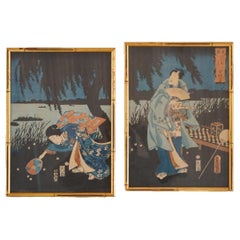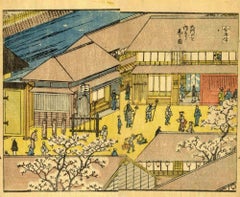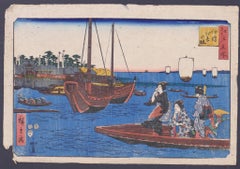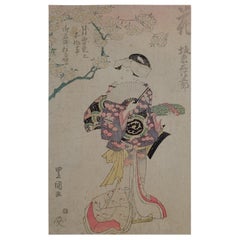Utagawa Hiroshige II Art
to
1
3
2
4
4
2
1
1
1
Kiyomizu Temple, Scenes of Famous Places along Tôkaidô Road - Woodblock on Paper
By Utagawa Hiroshige II
Located in Soquel, CA
Kiyomizu Temple, Scenes of Famous Places along Tôkaidô Road - Woodblock on Paper
Full Title:
Kyoto: Kiyomizu Temple (Kyô Kiyomizudera), from the series Scenes of Famous Places along...
Category
1860s Edo Utagawa Hiroshige II Art
Materials
Ink, Rice Paper, Woodcut
Two Japanese Woodblock Gere Prints by Utagawa Hiroshige II, Framed, 20thC
By Utagawa Hiroshige II
Located in Big Flats, NY
Two Japanese Woodblock Gere Prints with Figures by Utagawa Hiroshige II, Framed, 20thC
Measures- 14.5''H x 10.75''W x 1''D
Category
20th Century Utagawa Hiroshige II Art
Materials
Paper
Wandering Monks in the Courtyard of Konoura - Woodcut by U. Hiroshige II - 1840s
By Utagawa Hiroshige II
Located in Roma, IT
Wandering monks in the courtyard of Konoura is an original modern artwork realized by Utagawa Hiroshige II (1826 – 1869) in the 1840s.
Good impression with reduced palette mainly in...
Category
1840s Modern Utagawa Hiroshige II Art
Materials
Paper, Woodcut
Bamboo Rooms in Iwahisa - Woodcut by Utagawa Hiroshige II - 1840s
By Utagawa Hiroshige II
Located in Roma, IT
Bamboo Rooms in Iwahisa is an original modern artwork realized by Utagawa Hiroshige II (1826 – 1869) in the 1840s.
Very good impression with reduced palette mainly in blue, green an...
Category
1840s Modern Utagawa Hiroshige II Art
Materials
Paper, Woodcut
Tsukuda Sumiyoshi no Yashiro - Woodcut by Hiroshige II - 1853
By Utagawa Hiroshige II
Located in Roma, IT
Tsukuda Sumiyoshi no yashiro (Sumiyoshi Shrine on Tsukuda Island) is the original title of this superb ten colour woodblock print on paper, by the Japanese master, Utagawa Hiroshige ...
Category
1850s Utagawa Hiroshige II Art
Materials
Woodcut, Paper
Related Items
Japanese Woodblock Print by Utagawa Toyokuni I
Located in Norton, MA
Japanese Woodblock Print by Utagawa Toyokuni I (1769~1852), original and unframed.
ABOUT THE ARTIST
Utagawa Toyokuni (Japanese: ????; 1769 in Edo – 24...
Category
Early 19th Century Japanese Antique Utagawa Hiroshige II Art
Materials
Paper
Utagawa Hiroshige 歌川廣重 Woodblock Print, Koume Embankment
Located in Norton, MA
Utagawa Hiroshige (1797–1858)
One Hundred Famous Views of Edo - Koume Embankment
mounted on a cardboard
Artist:
Utagawa Hiroshige is recognized as a master of the ukiyo-e woodblock ...
Category
19th Century Japanese Antique Utagawa Hiroshige II Art
Materials
Paper
"First Horse Day, 1896" - Chiyoda Palace - Japanese Woodblock by Chikanobu Yoshu
By Toyohara Chikanobu
Located in Soquel, CA
"First Horse Day, 1896" - Chiyoda Palace - Japanese Woodblock by Chikanobu Yoshu
Colorful and expressive court scne by Toyohara Chikanobu,"Yoshu" (Japanese, 1838-1912).
This is the r...
Category
1890s Edo Utagawa Hiroshige II Art
Materials
Rice Paper, Ink, Woodcut
H 15 in W 10.5 in D 0.5 in
Mitate of a Daimyo's Procession Crossing Ryogoku Bridge - Woodblock Print
By Keisai Eisen
Located in Soquel, CA
Mitate of a Daimyo's Procession Crossing Ryogoku Bridge - Woodblock Print
Woodblock print of a procession by Keisai Eisen (Japanese, 1790–1848). Terrific triptych of a procession of...
Category
Early 19th Century Edo Utagawa Hiroshige II Art
Materials
Woodcut, Rice Paper, Ink
H 24 in W 36 in D 0.25 in
Utagawa Ando Hiroshige Japanese Woodblock Print Kinryuzan Temple, Asakusa
By Utagawa Hiroshige (Ando Hiroshige)
Located in Studio City, CA
A wonderful Japanese woodblock print by famed Japanese artist Utagawa Hiroshige (Ando Hiroshige) (1797-1858) titled "Kinryuzan Temple, Asakusa" was initially conceived in 1856. It i...
Category
20th Century Japanese Edo Utagawa Hiroshige II Art
Materials
Paper
H 14.5 in W 9.5 in D 0.1 in
Utagawa Hiroshige 歌川廣重 Woodblock Print R2 "Thirty-Six Views of Mount Fuji" 1852
Located in Norton, MA
Utagawa Hiroshige ???? Woodblock Print "Thirty-Six Views of Mount Fuji" 1848
Artist:
Utagawa Hiroshige is recognized as a master of the ukiyo-e woodblock printing tradition, havi...
Category
Mid-19th Century Japanese Antique Utagawa Hiroshige II Art
Materials
Paper
H 6.35 in W 9.35 in D 0.15 in
"Various Himochi" Wagashi Festival Japanese Woodblock Print by Utagawa Toyokuni
Located in Soquel, CA
"Various Himochi" Wagashi Festival Japanese Woodblock Print by Utagawa Toyokuni
Rare oversized early 19th century 5-tiered woodblock by Utagawa Ichiyosai Toyokuni, (Japan, 1769-1825), a Japanese lord and wife oversee a sekku festival of food, music, and dolls or toys. '"oshi" is the first day of “Mi (Snake)” in the third month of the lunar calendar. This day, known in modern Japan as the Girls' Festival, originated in China as a form of purification ceremony in which water and drinking peach blossom wine were used to drive away evil. Many kinds of hishi-mochi appear in this picture of hina ningyo (dolls associated with Hinamatsuri, or the Girl’s Day) from Omochae.
The custom of eating special dishes at events throughout the year and at milestones in people's lives has existed since ancient times. This paragraph specifically focuses on the annual event called sekku, and life events that involve eating sweets. Joshi is the first day of “Mi (Snake)” in the third month of the lunar calendar. This day, known in modern Japan as the Girls' Festival, originated in China as a form of purification ceremony in which water and drinking peach blossom wine were used to drive away evil. According to the Keiso saijiki, in ancient China, on the third day of the third lunar month, people ate “ryuzetsuhan,” which is the juice of gogyo (Jersey cudweed) mixed with rice flour and nectar. In Japan, there is a record in the Heian period history book Nihon Montoku tenno jitsuroku [839-5] that it was an annual event to make kusamochi using gogyo on the third day of the third month of the lunar calendar, which may have been influenced by Chinese customs.
The tradition of eating kusamochi on the third day of the third month of the lunar calendar continued after that. By the Edo period, however, hishimochi had come to be used as a sweet to serve on the third day of the third month. A picture of a hishimochi is included in the Morisada manko , which we mentioned in Part 1. According to it, hishimochi in the Edo period were often three layers of green-white-green instead of the now common red-white-green. However, it is possible to see from our collection that not all hishimochi were made in this way. Omochae published in 1857, is a good example. Omochae is a type of ukiyoe print...
Category
1820s Edo Utagawa Hiroshige II Art
Materials
Ink, Rice Paper, Woodcut
H 26.75 in W 21.75 in D 0.25 in
Sumiyoshi: Dengaku dance performed during an Onda ceremony - Woodblock Print
By Utagawa Hiroshige
Located in Soquel, CA
Sumiyoshi: Dengaku dance performed during an Onda ceremony - Woodblock Print
Bright woodblock print by Utagawa Hiroshige (Japanese, 1797-1858). In this scene, two dancers with swords and fans are facing each other, in the center of a courtyard. There are spectators surrounding them, including nobles in black clothing on a balcony.
Presented in a new off-white mat with foamcore backing.
Mat size: 16"H x 20"W
Paper size: 9.63"H x 14.5W"
Utagawa Hiroshige (1797-1858, sometimes called Ando Hiroshige) was the second of the two great masters of the Japanese landscape woodblock print...
Category
1830s Edo Utagawa Hiroshige II Art
Materials
Ink, Rice Paper, Woodcut
Narihira's Journey to the East - Japanese Woodblock on Paper by Kikugawa Eizan
By Kikugawa Eizan
Located in Soquel, CA
Narihira's Journey to the East - Japanese Woodblock on Paper
Original 19th century Japanese woodcut print depicting Narihira's journey to the East by a follower of Utamaru,
Kikugaw...
Category
Early 19th Century Edo Utagawa Hiroshige II Art
Materials
Woodcut, Rice Paper, Ink
Utagawa Ando Hiroshige Woodblock Print J001, Japan
By Utagawa Hiroshige (Ando Hiroshige)
Located in Norton, MA
Rare find, Utagawa Ando Hiroshige, Japanese, 1797 to 1858, woodblock prints on paper, peach and swallows in moonlight. The first is signed and i...
Category
Early 19th Century Japanese Edo Antique Utagawa Hiroshige II Art
Materials
Paper
'Madman's Drum (Plate 41)' — 1930s Graphic Modernism
By Lynd Ward
Located in Myrtle Beach, SC
Lynd Ward, 'Madman's Drum, Plate 41', wood engraving, 1930, edition small. Signed in pencil. A fine, black impression, on off-white tissue-thin Japan paper; the full sheet with margins (1 5/8 to 2 1/2 inches); a small paper blemish in the upper right margin, away from the image, otherwise in excellent condition. Scarce. Matted to museum standards, unframed.
Image size 5 1/2 x 3 3/4 inches (140 x 95 mm); sheet size 9 5/8 x 7 1/8 inches (244 x 181 mm).
From Lynd Ward’s book of illustrations without words, 'Madman’s Drum', Jonathan Cape and Harrison Smith, New York, 1930. Illustrated in 'Storyteller Without Words: The Wood Engravings of Lynd Ward', Harry Abrams, New York, 1974.
Reproduced in 'Storyteller Without Words, the Wood Engravings of Lynd Ward', Harry N. Abrams, New York, 1974.
ABOUT THE ARTIST
Lynd Ward is acknowledged as one of America’s foremost wood engravers and book illustrators of the first half of the twentieth century. His innovative use of narrative printmaking as a stand-alone storytelling vehicle was uniquely successful in reaching a broad audience. The powerful psychological intensity of his work, celebrated for its dynamic design, technical precision, and compelling dramatic content, finds resonance in the literature of Poe, Melville, and Hawthorne. Like these classic American writers, Ward was concerned with the themes of man’s inner struggles and the role of the subconscious in determining his destiny. An artist of social conscience during the Great Depression and World War II, he infused his graphic images with his unique brand of social realism, deftly portraying the problems that challenged the ideals of American society.
The son of a Methodist preacher, Lynd Ward, moved from Chicago to Massachusetts at an early age. He graduated from the Teachers College of Columbia University, New York, in 1926, where he studied illustration and graphic arts. He married May Yonge McNeer in 1936 and left for Europe for their honeymoon in Eastern Europe. After four months, they settled in Leipzig, where Ward studied at the National Academy of Graphic Arts and Bookmaking. Inspired by Belgian expressionist artist Frans Masereel's graphic novel ‘The Sun,’ and another graphic novel by the German artist Otto Nückel, ‘Destiny,’ he determined to create his own "wordless" novel. Upon his return to America, Ward completed his first book, ‘God's Man: A Novel in Woodcuts,’ published in 1929. ‘Gods’ Man’ was a great success for its author and publisher and was reprinted four times in 1930, including a British edition. This book and several which followed it, ‘Madman’s Drum,’ 1930, ‘Wild Pilgrimage...
Category
1930s American Modern Utagawa Hiroshige II Art
Materials
Woodcut
The Pilgrimage Procession to Kinryuzan Temple at Asakusa in the Eastern Capital
By Kuniyasu
Located in Soquel, CA
Japanese Parade - Woodblock Print
Japanese woodblock print by Utagawa Kuniyasu (歌川 国安) (Japan, 1794–1832). Japanese women, dressed in blue and red kimonos, are the focal point. A vi...
Category
Mid-19th Century Edo Utagawa Hiroshige II Art
Materials
Paper, Ink, Woodcut
Previously Available Items
Utagawa Hiroshige Portfolio of 24 Vintage Japanese Woodblocks 20th Century
By Utagawa Hiroshige II
Located in Keego Harbor, MI
A fantastic collector's item of Japanese art - a complete portfolio by Utagawa Hiroshige. This was is an after edition, circa mid 20th century. The set has 12 individual folders with...
Category
20th Century Utagawa Hiroshige II Art
Materials
Paper
H 13.25 in W 19.75 in D 2 in
Dragon Room in Iwahisa - Original Woodcut by Utagawa Hiroshige II - 1840s
By Utagawa Hiroshige II
Located in Roma, IT
Dragon Room in Iwahisa is an original modern artwork realized by Utagawa Hiroshige II (1826 – 1869) in the 1840s.
Good impression with reduced palette mainly in blue, green and yell...
Category
1840s Modern Utagawa Hiroshige II Art
Materials
Paper, Woodcut
Utagawa Hiroshige IIDragon Room in Iwahisa - Original Woodcut by Utagawa Hiroshige II - 1840s, 1840s
H 7.88 in W 11.82 in D 0.04 in
Meishoe - Original Woodcut by Utagawa Hiroshige II - 1830s
By Utagawa Hiroshige II
Located in Roma, IT
Meishoe is an original modern artwork realized by Utagawa Hiroshige II (1826 – 1869) in the 1830s..
Oban Yoko-e.
From the famous Tokaido series of 1833, the most famous print of th...
Category
1830s Modern Utagawa Hiroshige II Art
Materials
Paper, Woodcut
H 10.01 in W 14.97 in D 0.04 in
Antique Japanese Woodblock Print of Village Scene after Hiroshige, circa 1850
By Utagawa Hiroshige II
Located in Big Flats, NY
An antique Japanese Hiroshige woodblock print depicts village scene with figures, horses, structures (pagodas) and lake in the background, si...
Category
19th Century Japanese Antique Utagawa Hiroshige II Art
Materials
Paper
H 19.75 in W 15 in D 0.5 in
Catching Fireflies by the Uji River in Yamashiro Province
By Utagawa Hiroshige II
Located in Fairlawn, OH
Hiroshige ga, Toyokuni ga in toshidama cartouche;
Censor's seal: Chicken 8 aratame;
Blockcutter's mark: Horikô Mino, center sheet only, (Japanese, 1833-1906)
and Utagawa Ku...
Category
Mid-19th Century Utagawa Hiroshige II Art
Materials
Woodcut
Utagawa Hiroshige Ii art for sale on 1stDibs.
Find a wide variety of authentic Utagawa Hiroshige II art available for sale on 1stDibs. You can also browse by medium to find art by Utagawa Hiroshige II in paper, woodcut print and more. Much of the original work by this artist or collective was created during the 19th century and is mostly associated with the modern style. Not every interior allows for large Utagawa Hiroshige II art, so small editions measuring 9 inches across are available. Customers who are interested in this artist might also find the work of Utagawa Yoshitora, Keisei Eisen, and Kaoru Kawano. Utagawa Hiroshige II art prices can differ depending upon medium, time period and other attributes. On 1stDibs, the price for these items starts at $334 and tops out at $1,563, while the average work can sell for $718.








